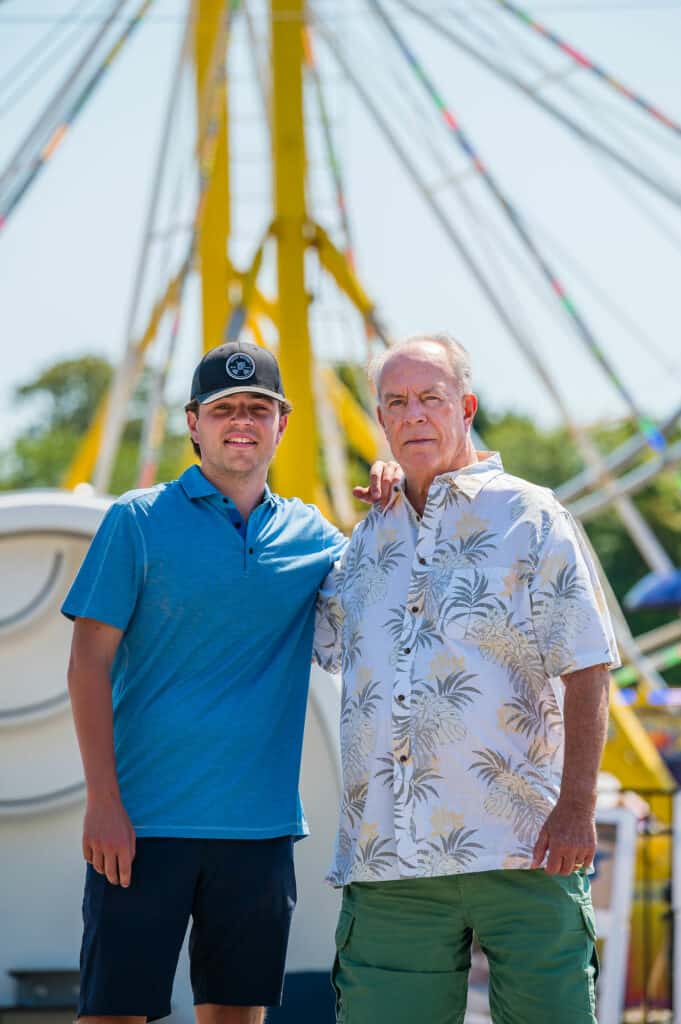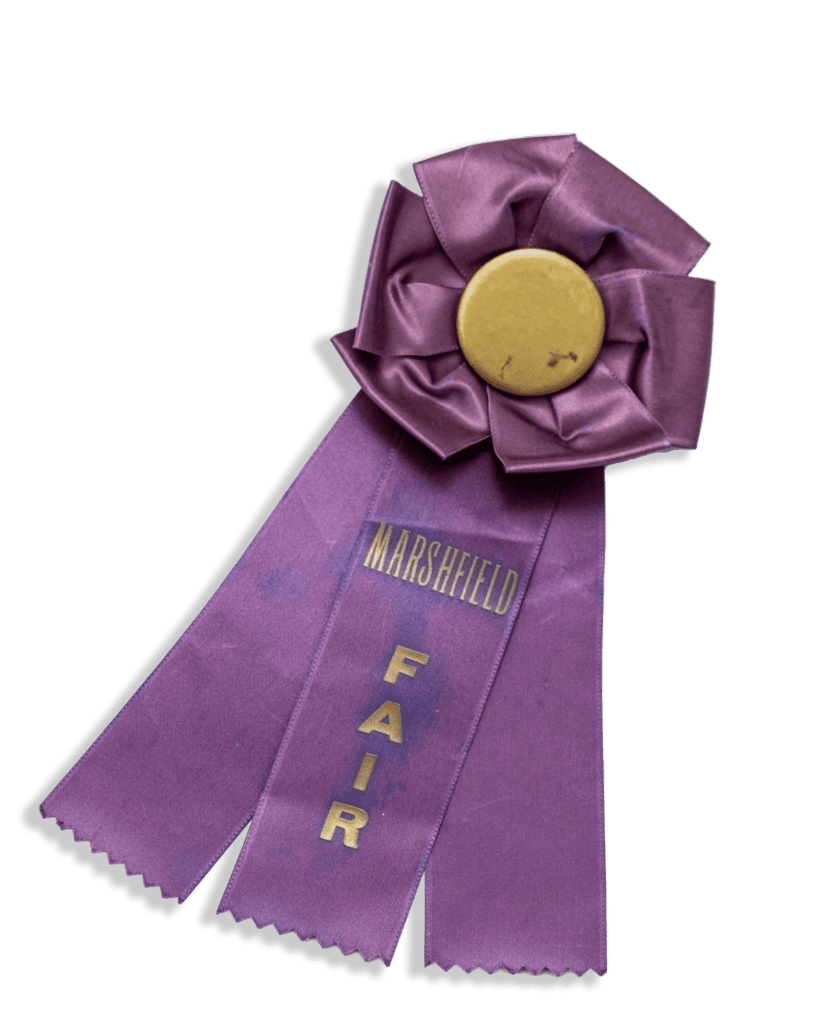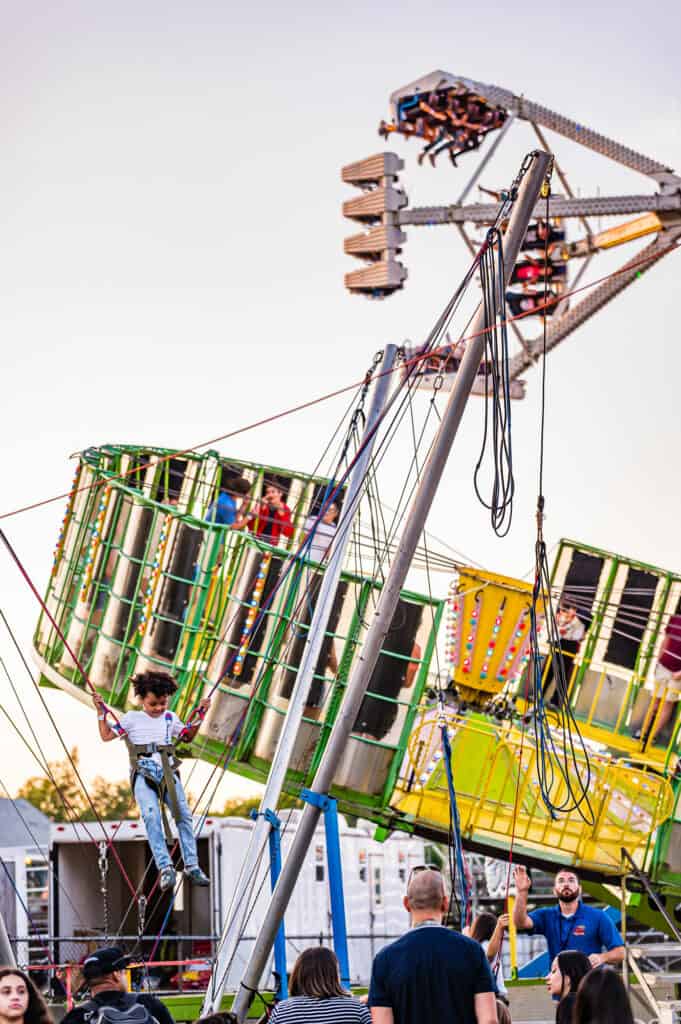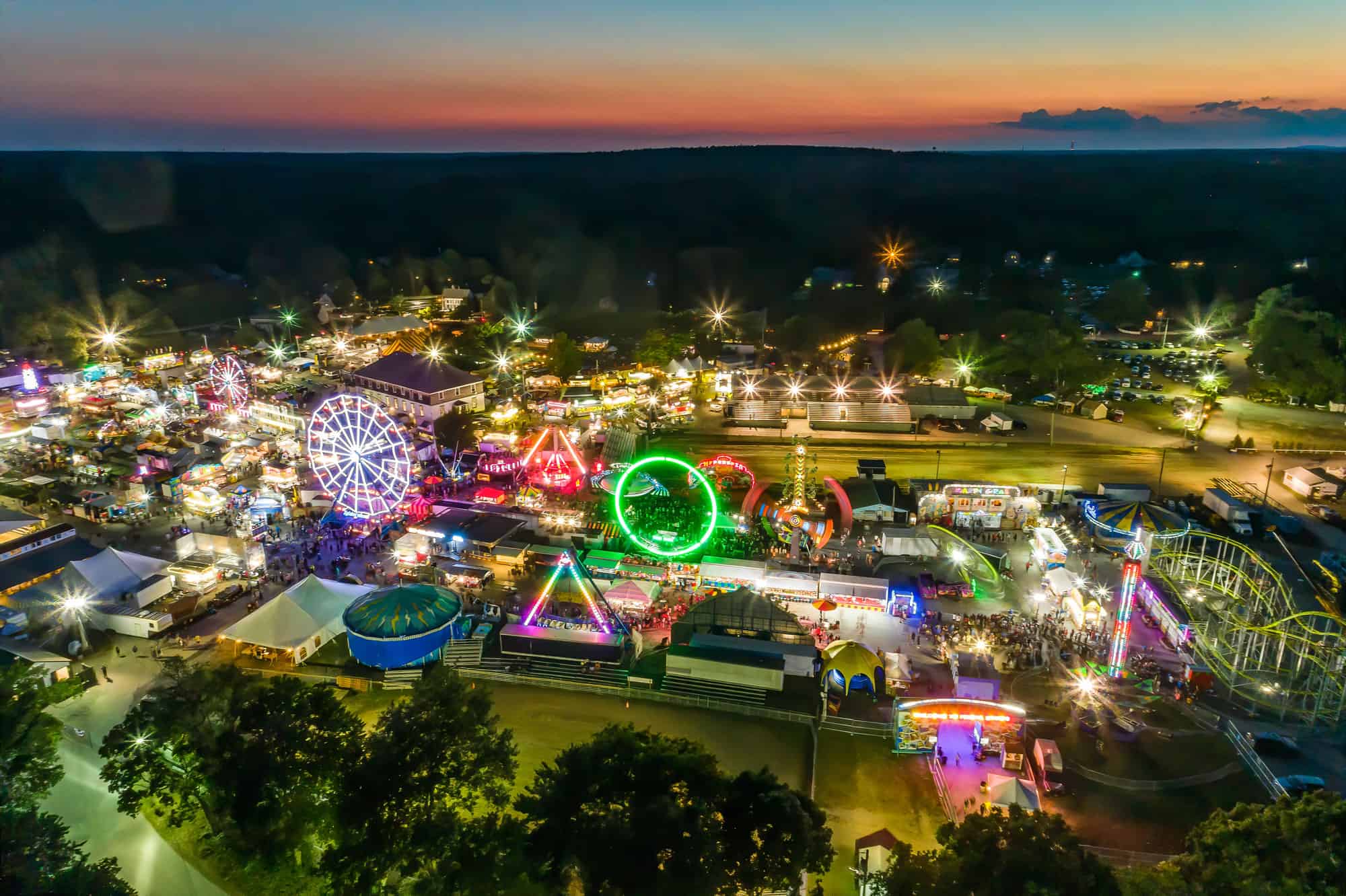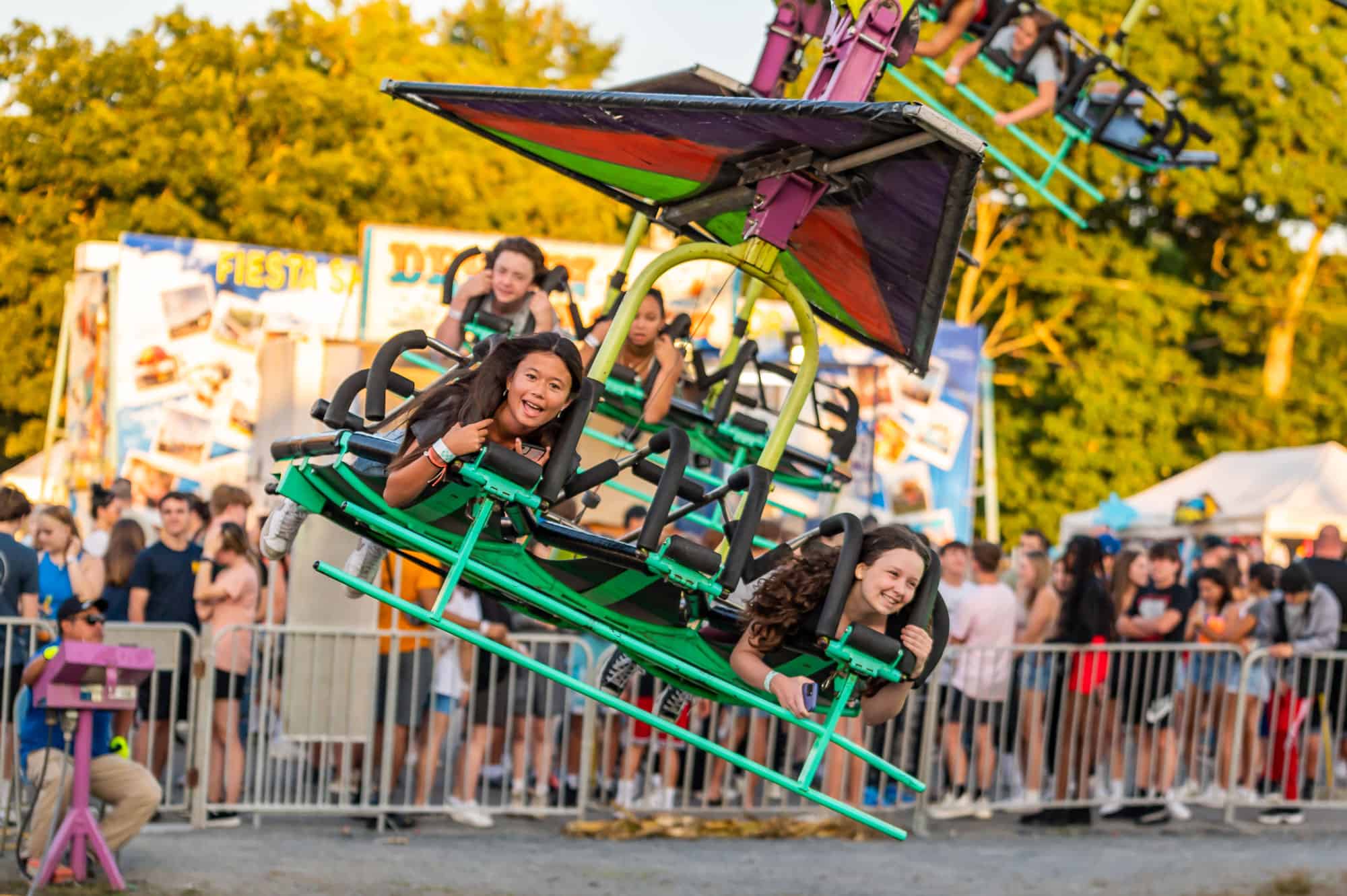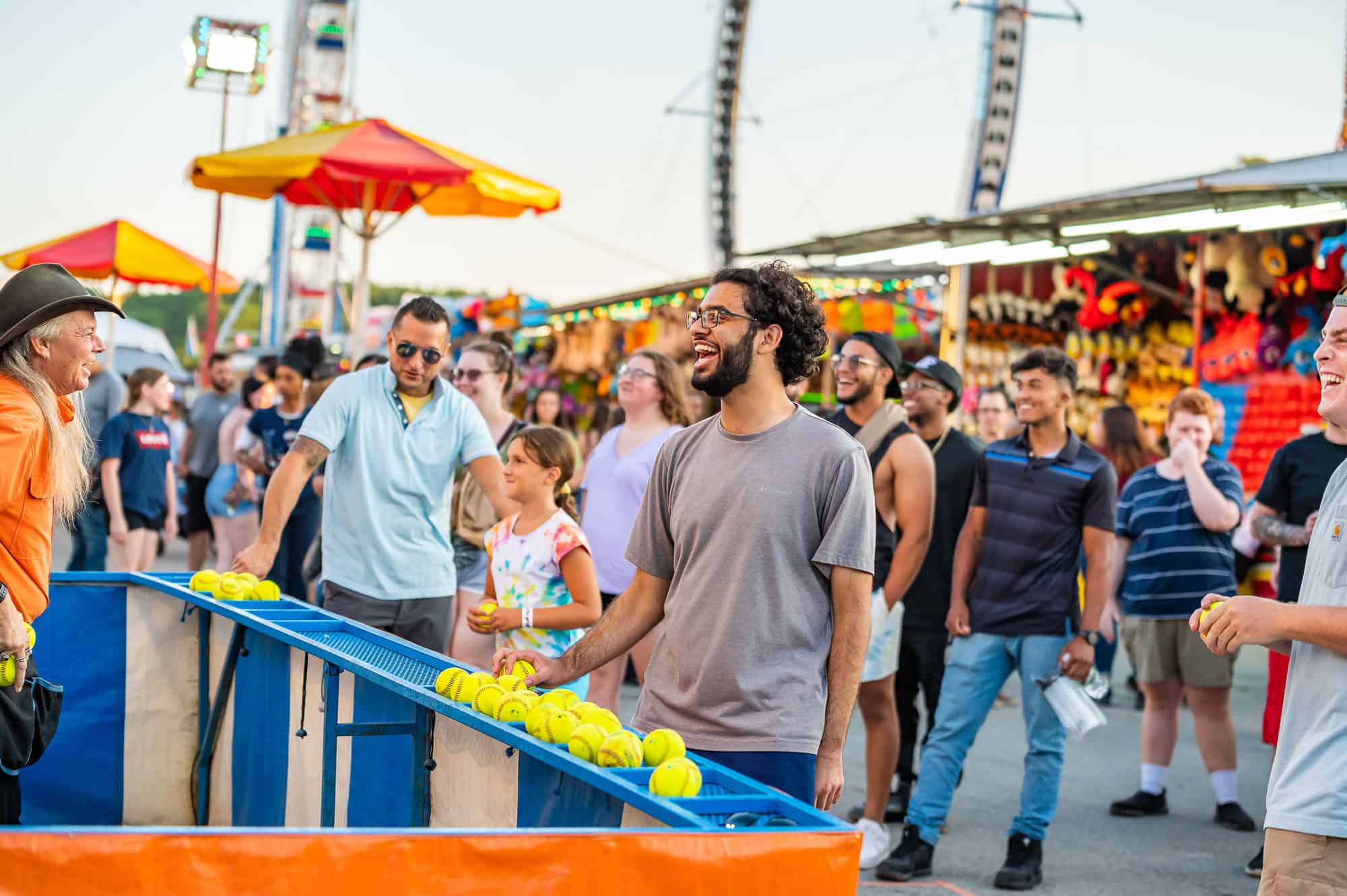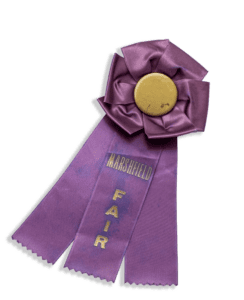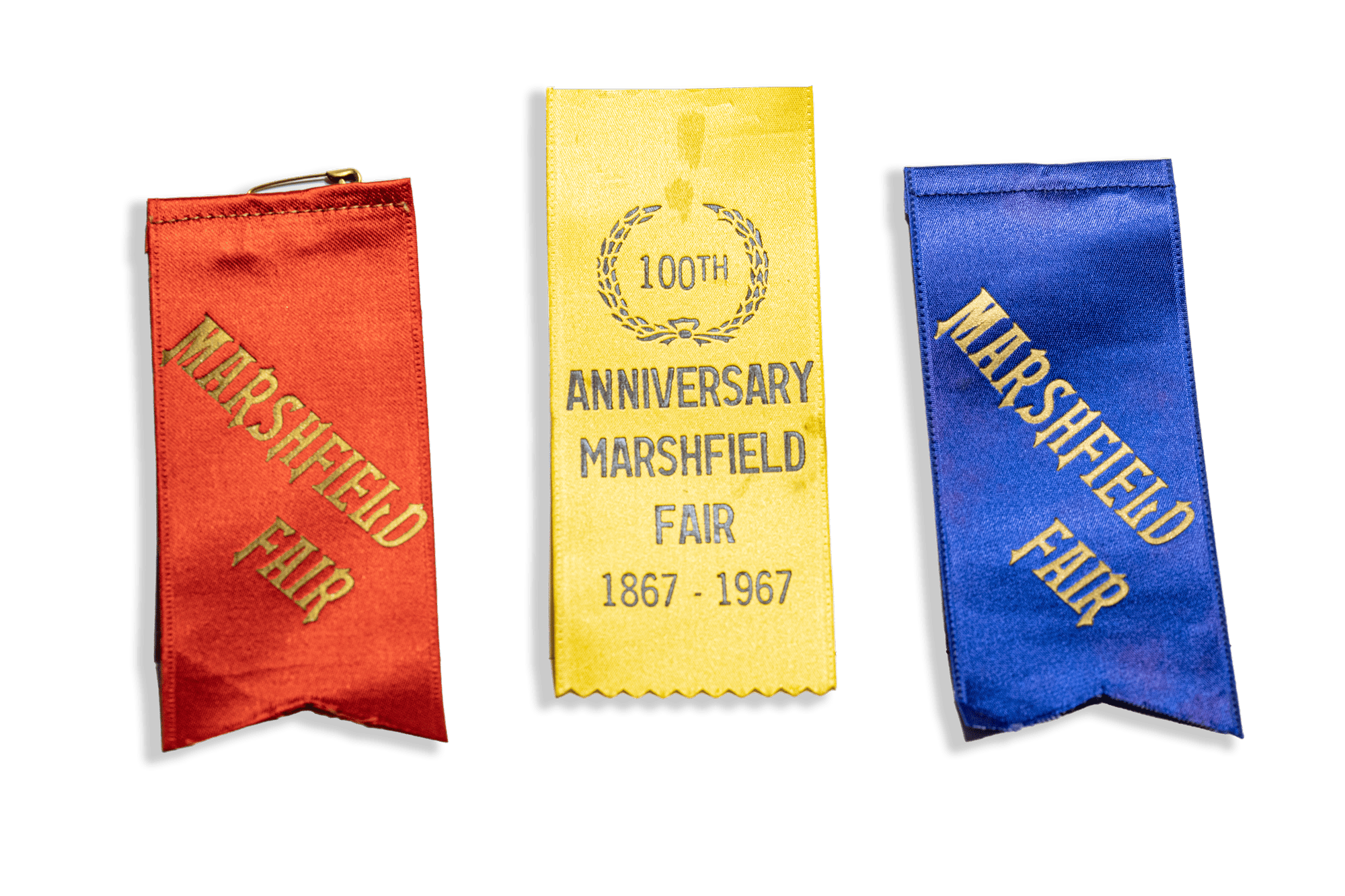An annual summertime tradition delivers family entertainment, nostalgia and new fun features.
By Jennifer H. McInerney Photography by Kjeld Mahoney
Each summer, as mid-August approaches, motorists passing the Marshfield Fairgrounds along Route 3A undoubtedly notice a conspicuous change in scenery: multicolored tents sprouting up, flags being hoisted and banners unfurled, camels, monkeys and other exotic animals taking their place at the petting zoo on the corner, and—the ultimate telltale sign—the Ferris wheel rising high into the sky.
For 156 years, the Marshfield Agricultural and Horticultural Society has been staging the annual Marshfield Fair, a 10-day event that transforms the 62-acre landscape of the Marshfield Fairgrounds with myriad barnyard animals, farming equipment and locally grown produce, the flashing and blinking lights of midway games of chance and thrill rides, diverse food vendors, several stages featuring live musical acts, magicians and other entertainers, and a grandstand thundering with the sounds of revving engines and applause.
“The Marshfield Fair is an enjoyable, safe place to go with your whole family,” says Lenny LaForest, president of the Marshfield Agricultural and Horticultural Society, which organizes the annual fair. “There’s something for everyone. You can spend the whole day here; there’s so much to see and do.”
The scope of the Marshfield Fair has grown exponentially since the mid-1860s, when a fledgling group of local farmers hosted a gathering on the Town Common to exhibit agricultural and horticultural products—which attracted 9,000 visitors. (For additional information about the history of the Marshfield Fair, see sidebar.)
And yet, amid the excitement and stimulation that whirls around the modern-day fair, the founding farmers’ mission to share agricultural and horticultural knowledge with the local community quietly continues. Daily workshops and demonstrations are offered on a range of traditional topics, such as: how to grow hydrangeas and sunflowers, creating fall container gardens, organic lawn care, butterfly hatching, woodturning, Russian needlepoint, folk art painting, polymer clay crafts, soap-making, chair-caning, rug-hooking, and more.
Helping to cultivate the art of farming, the fair also conducts contests recognizing excellence in a variety of categories, including 4-H and animals, agriculture, arts and crafts, horticulture, photography, and horse, oxen and pony pulls. Livestock events encompass poultry, cattle, goats, camelids, swine, sheep, equine, rabbits, and dogs and cats. Agricultural competitions call for exhibitors in all manner of garden vegetables, from beans to zucchini squash, native fruits, canned goods and honey. A perennial favorite is the New England Giant Pumpkin Contest; the record-holder is Steve Connolly of Sharon, whose winning entry weighed in at a whopping 1,602 pounds at the 2018 Marshfield Fair.
Running the Fair is a Family Affair
LaForest’s family moved from Plymouth to Marshfield in the 1950s, when he was 2 years old. He remembers the hometown of his youth as a “country town,” with a population of about 1,000 citizens. His father, Leonard “John” LaForest, owned the LaForest Village Shoppe next to the Congregational Church and often socialized with other local business owners, including Russell Chandler, who owned a radio shop and was a member (and later president) of the Marshfield Agricultural and Horticultural Society. The elder LaForest signed on to help with the operation of the Marshfield Fair, as a member of the board of directors’ management committee—and stayed on for about 50 years.
“The fair was floundering a bit back then, and he helped get it back on track,” the younger LaForest recalls. During his high school years, Lenny LaForest helped his father, who ran the four beer concession stands at the fair. He spent most of the fair running from one end of the grandstand to another, out to the infield, and back to the beer stand next to Aggie Hall, keeping provisions well stocked for the racetrack crowd. By the 1980s, the “older generation” wanted to welcome the “younger generation” into leadership positions, and he accepted an appointment to the board of directors.
LaForest, a retired Marshfield Police Sergeant and Harbormaster, has served as president of the Marshfield Agricultural and Horticultural Society for 33 years.
“We’ve had some difficult years, but we’ve managed to survive it,” he says. “The fair is more financially stable than it’s ever been in its existence.”
Continuing the legacy of involvement in this historic annual tradition, a third generation of the family has entered the fair’s fold. In 2021, LaForest’s nephew, Noel Powers, followed in his uncle’s and grandfather’s footsteps and joined the Marshfield Agricultural and Horticultural Society Board of Directors. Like his uncle, Powers grew up with the Marshfield Fair, and started helping with the annual event’s preparation during his high school summers, two decades ago, painting buildings and cutting grass.
“This is a family event, so it means a lot to work together with family to put it on,” says Powers. He’s one of many second- and third-generation contributors carrying on the custom of family involvement with the Marshfield Fair, from the 4-H exhibitors to the food vendors. “There are numerous multigenerational groups working to help pull the fair together, continuing the tradition established by their ancestors,” says Powers. “We like to keep those local ties.”
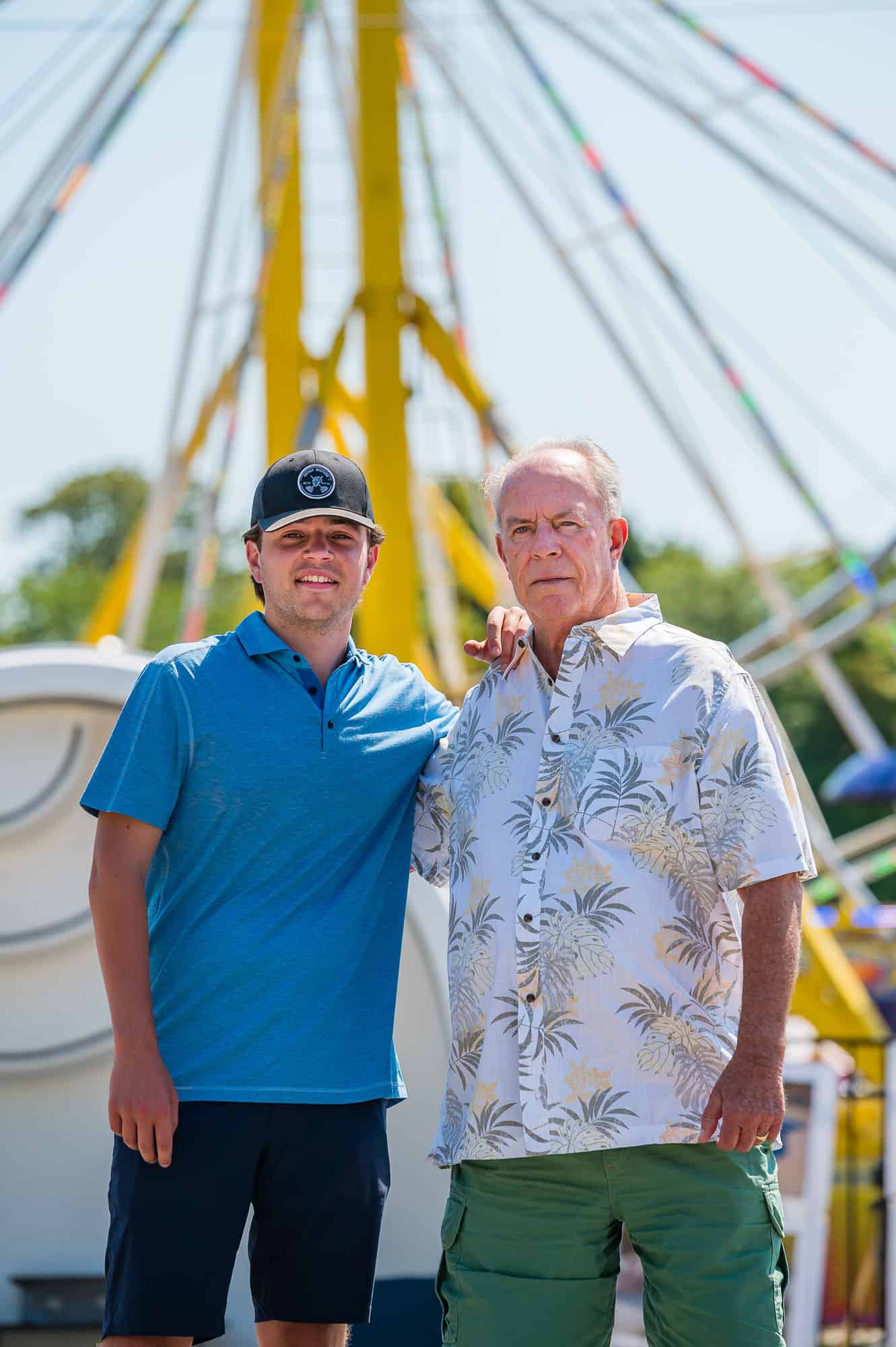
Lenny LaForest (bottom right) is President of Marshfield Agricultural and Horticultural Society (MAHS). His nephew, Noel Powers, is a member of the MAHS board and part of the third generation helping to keep summer traditions alive at the Marshfield Fair.
Balancing Act: Preserving the Past While Embracing the Future
The Marshfield Fair has withstood the tests of time, navigating more than a century-and-a-half of technological progress, not to mention wars, economic recessions and the Covid-19 pandemic.
One notable event in the fair’s history was the elimination of horse racing on the fairgrounds’ half-mile track. Introduced in the early 1900s, thoroughbred and sulky (standardbred horses pulling a two-wheeled cart) racing drew enthusiastic crowds from throughout the region for nearly a century.
“People are always asking me, ‘When is the fair going to bring horse racing back?’,” says LaForest. “We were more or less forced to give it up, and it’s not a feasible entity today.”
In 1991, the state racing commission did not renew the Marshfield Fair’s usual late-August race dates, granting them instead to a newly opened track in Foxboro and pushing Marshfield’s meet dates back to September. Rather than reschedule the fair to accommodate this change, the board of directors revamped the roster of racetrack spectacles—including tractor-pulls and the fan-favorite Demolition Derby—and expanded attractions around the grandstand area.
In addition, the board of directors continues to focus on modernization, a delicate balancing act between staying rooted in tradition while ensuring the growth of the fair. “We want to keep the things that people come back for year after year, while also staying relevant to the times and bringing new excitement to the fair,” says Powers.
To that end, Powers and the board have developed partnerships that have led to the introduction of new vendors and attractions; gourmet food trucks that elevate the dining experience beyond fried food; new entertainment acts, including the first-ever country music weekend during the first weekend of the fair last year; and a new partnership with Castle Island Brewery to bring its IPA to the fair. Also new this year: in addition to Marshfield Residents Day (discounted), Senior Citizens Day (free), 4-H Agricultural Awareness Day (free), and Children’s Day (free under 12), the fair is designating a Veterans Day and offering free admission to individuals who qualify.
Along with this new wave of innovations, the fair’s familiar favorites endure, from the annual quilting display, to the birds of prey, face painting, pony rides, chainsaw sculptor, fried dough and cotton candy.
“It’s amazing to watch how people react to different parts of the fair,” says LaForest. “Old, young and in-between all having a good time, and the kids are shrieking with delight because they’re having so much fun. That’s my favorite thing about the fair.”
Marshfield Fair Timeline
1867: The Inaugural Marshfield Fair
The Marshfield Agricultural and Horticultural Society staged the first-ever Marshfield Fair,establishing what has become an annual favorite event on the South Shore for more than 150 years. The group purchased the property on South River Street that is now the Marshfield Fairgrounds.
1870s: Establishing the Foundation
Construction began on an exhibition hall, now called Agricultural Hall, to root the Marshfield Agriculture and Horticultural Society firmly in the community. The Hall, which once hosted Marshfield Town Meetings, continues to serve as the fair’s centerpiece for exhibiting arts, crafts and produce.
1905-1910: Addition of Horse Racing
Serving as the Society’s president, Scituate lumber magnate Thomas Lawson had an interest in thoroughbred and sulky—standardbred horses pulling a two-wheeled cart—racing. He spearheaded the construction of additional barns and sheds throughout the fairgrounds as well a grandstand and half-mile racetrack for horse racing, which became a main attraction of the fair for nearly a century.
1912-1930: Off to the Races!
In addition to horse racing, the track featured races for motorcycles—including the 1912 championship Merze motorcycle, manufactured in Brockton—and Model A Fords by local drivers. Additionally, Presidents Warren G. Harding and Calvin Coolidge also made visits to the fair
1930s-1940s: Death-Defying Feats
In addition to racing, the Marshfield Fair drew crowds with exciting live entertainment, including high-wire acts, the Barrel of Death motorcycle stunt spectacle, stage shows, band concerts and fireworks.
1946: Welcoming Women Exhibitors
For the first eight decades of the Marshfield Fair’s existence, men were the main exhibitors. In 1946, the fair welcomed the Women’s Exchange, enabling women to display and sell their crafts, and led to cooking and baking contests.
1950-1990: Cultivating Steady Growth
Over the next 40 years, the Marshfield Agricultural and Horticultural Society expanded the fair’s attractions and its appeal with 4-H contests, agricultural and horticultural exhibits, arts and crafts displays, midway rides and games of chance, musical entertainment, horse racing and car thrill shows on the track.
1991: The Finish Line for Horse Racing
Horse Racing at the fair came to an abrupt halt when the state racing commission awarded Marshfield’s meet dates to a newly opened track in Foxboro. Marshfield’s dates were moved back two weeks, which did not coincide with the fair’s tradition of late-August family fun.
2000: Expansion of Off-Season Events
To help offset year-round maintenance expenses of the Marshfield Fairgrounds, the Society opted to open its venue during the off-season to outside organizations, including Spindles Auto Club, an annual flea market, several music festivals, such as Levitate, and a year-round farmers market.
2020: Marshfield Fair Canceled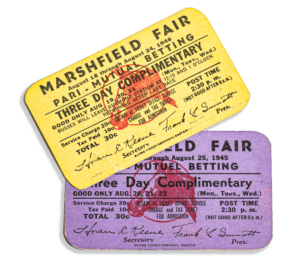
For only the second time in its long history, the Marshfield Agricultural and Horticultural Society had to cancel the annual Marshfield Fair due to the Covid-19 pandemic. The only other time the fair had been canceled was during World War II.
Present Day: Continuing the Tradition
While the fair has expanded and diversified to reflect modern-day preferences, this annual tradition continues to honor the past with its ongoing commitment to the founding farmers’ agricultural and horticultural roots.

